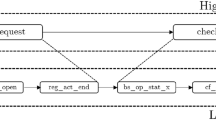Abstract
Most workflow management systems (WfMSs) only support the separate andindependent execution of business processes. However, processes often needto interact with each other, in order to synchronize the execution of theiractivities, to exchange process data, to request execution of services, orto notify progresses in process execution. Recent market trends also raisethe need for cooperation and interaction between processes executed in differentorganizations, posing additional challenges. In fact, in order to reduce costsand provide better services, companies are pushed to increase cooperation and toform virtual enterprises, where business processes span across organizationalboundaries and are composed of cooperating workflows executed in differentorganizations. Workflow interaction in a cross-organizational environment iscomplicated by the heterogeneity of workflow management platforms on top ofwhich workflows are defined and executed and by the different and possiblycompeting business policies and business goals that drive process executionin each organization.
In this paper we propose a model and system that enable interactionbetween workflows executed in the same or in different organizations. Weextend traditional workflow models by allowing workflows to publish andsubscribe to events, and by enabling the definition of points in the processexecution where events should be sent or received. Event notifications aremanaged by a suitable event service that is capable of filtering andcorrelating events, and of dispatching them to the appropriate targetworkflow instances. The extended model can be easily mapped onto anyworkflow model, since event specific constructs can be specified by means ofordinary workflow activities, for which we provide the implementation. Inaddition, the event service is easily portable to different platforms, anddoes not require integration with the WfMS that supports the cooperatingworkflows. Therefore, the proposed approach is applicable in virtually anyenvironment and is independent on the specific platform adopted
Similar content being viewed by others
References
G. Alonso, U. Fiedler, C. Hagen, A. Lazcano, H. Schuldt, and N. Weiler, “Processes in electronic commerce,,” in ICDCS Workshop on Electronic Commerce and Web-Based Applications (ICDCS 99). Austin, Texas, 1999a.
G. Alonso, U. Fiedler, C. Hagen, A. Lazcano, H. Schuldt, and N. Weiler, “WISE: Business to business E-commerce,,” in Proceedings of RIDE-VE'99, Sydney, Australia, 1999b.
Baan Company, N.V.–COSA Solutions: 1998, “COSA Reference Manual.,”
F. Casati, “Models, semantics, and formal methods for the design of workflows and their exceptions.,” Ph.D. thesis, Dipartimento di Elettronica e Informazione, Milano, Italy, 1998.
F. Casati, S. Ceri, S. Paraboschi, and G. Pozzi, “Specification and implementation of exceptions in workflow management systems.,” ACM Transactions on Database Systems, 1999, to appear.
F. Casati and G. Pozzi, “Modeling and managing exceptions in commercial workflow management systems,,” in Proceedings of CoopIS '99. Edinburgh, U.K., 1999.
S. Ceri, E. Di Nitto, A. Discenza, A. Fuggetta, and G. Valetto, “DERPA: A generic distributed event-based reactive processing architecture.,” Technical report, CEFRIEL, 1998.
S. Ceri, R. Meo, and G. Psaila, “Composite events in chimera,” in Proceedings of the 6th International Conference on Extending Database Technology (EDBT'96). Avignon, France, Springer-Verlag, Berlin, 1996.
S. Chakravarthy, V. Krishnaprasad, E. Anwar, and S.-K. Kim, “Composite events for active databases: Semantics, contexts, and detection,,” in Proceedings of the 20th International Conference on Very Large Data Bases (VLDB'94). Santiago, Chile, pp. 606–617, 1994.
D. Chiu, K. Karlapalem, and Q. Li, “Exception handling with workflow evolution in ‘ADOMEWFMS’: A taxonomy and resolution techniques,” in Proceedings of the First Workshop on Adaptive Workflow Systems. Seattle, Washington, 1998. Available at http://ccs.mit.edu/klein/cscw98/paper06.
CrossFlow, “Esprit Project n. 28635,” 2000. Information available from www.crossflow.org.
A. Discenza, “Event-based reactive processing in distributed environments: model, language, and architecture.” Ph.D. thesis, Politecnico di Milano, 2000.
J. Eder and E. Panagos, “Towards distributed workflow process management,” in Proceedings of the WACC Workshop on Cross-organizational Workflows. San Francisco, CA, 1999.
D. Georgakopoulos, H. Shuster, A. Cichocki, and D. Baker, “Managing process and service fusion in virtual enterprises.” Information Systems, 1999, to appear.
C. Gerety, “HP SoftBench: A new generation of software development tools.” Hewlett-Packard Journal 41(3), pp. 48–59, 1990.
C. Hagen and G. Alonso, “Flexible exception handling in the OPERA process support system,” in Proceedings of the 18th International Conference on Distributed Computing Systems (ICDCS'98). Amsterdam, The Netherlands, 1998.
Hewlett Packard, “Changengine process design guide.” 2000.
IBM, “MQ series workflow–concepts and architectures.” 1998.
J. Klingemann, J. W. Sch, and K. Aberer, “Adaptive outsourcing in cross-organizational workflows.” Technical Report REP-IPSI-1998-30, Dipartimento di Elettronica e Informazione, GMD-German National Research Center for Information Technology, 1998.
D. Luckham and J. Vera, “An event-based architecture definition language.” IEEE Transactions on Software Engineering 21(9), pp. 717–734, 1995.
J. Mann, “Forte' Fusion.” Patricia Seybold Group report, 1998.
M. Mansouri-Samani and M. Sloman, “GEM: A generalised event monitoring language for distributed systems.” IEE/IOP/BCS Distributed Systems Engineering Journal 4(2), 1997.
R. T. Marshak, “InConcert Workflow.” Workgroup Computing report, Patricia Seybold Group 20(3), 1999.
Object Management Group, “Event service specification.” OMG Document, 1995. Available at ftp://ftp.omg.org/pub/docs/formal/97-02-09.ps.
J. Purtilo, “The POLYLITH software bus.” “ACM,” Transactions on Programming Language and Systems 16(1), pp. 151–174, 1994.
S. Reiss, “Connecting tools using message passing in the field program development environment.” IEEE Software 7(4), 1990.
K. Sheers, “HP OpenView event correlation service.” Hewlett-Packard Journal, 1996.
Staffware Corporation, “Staffware2000 white paper,” 1998. Available at http://www.staffware.com/ home/products/Staffware2000WP.zip.
Sun Microsystems, Inc., “Remote method invocation specification,” 1999. Available at http:// www.javasoft.com/products/jdk/1.1/docs/guide/rmi/spec/rmiTOC.doc.html.
W. van der Aalst, “Interorganizational workflows: An approach based on message sequence charts and petri nets.” Information Systems, 1999, to appear.
R. van Stiphout, T. D. Meijler, A. Aerts, D. Hammer, and R. le Comte, “TREX: Workflow Transactions by Means of EXceptions,” in Proceedings of the EDBT Workshop on Workflow Management Systems. Valencia, Spain, 1998.
S. Yemini, S. Kliger, E. Mozes, Y. Yemini, and D. Ohsie, “High speed and robust event correlation,” 1997. Available at http://www.smarts.com/products.html.
Author information
Authors and Affiliations
Rights and permissions
About this article
Cite this article
Casati, F., Discenza, A. Modeling and Managing Interactions among Business Processes. Journal of Systems Integration 10, 145–168 (2001). https://doi.org/10.1023/A:1011232926591
Issue Date:
DOI: https://doi.org/10.1023/A:1011232926591




